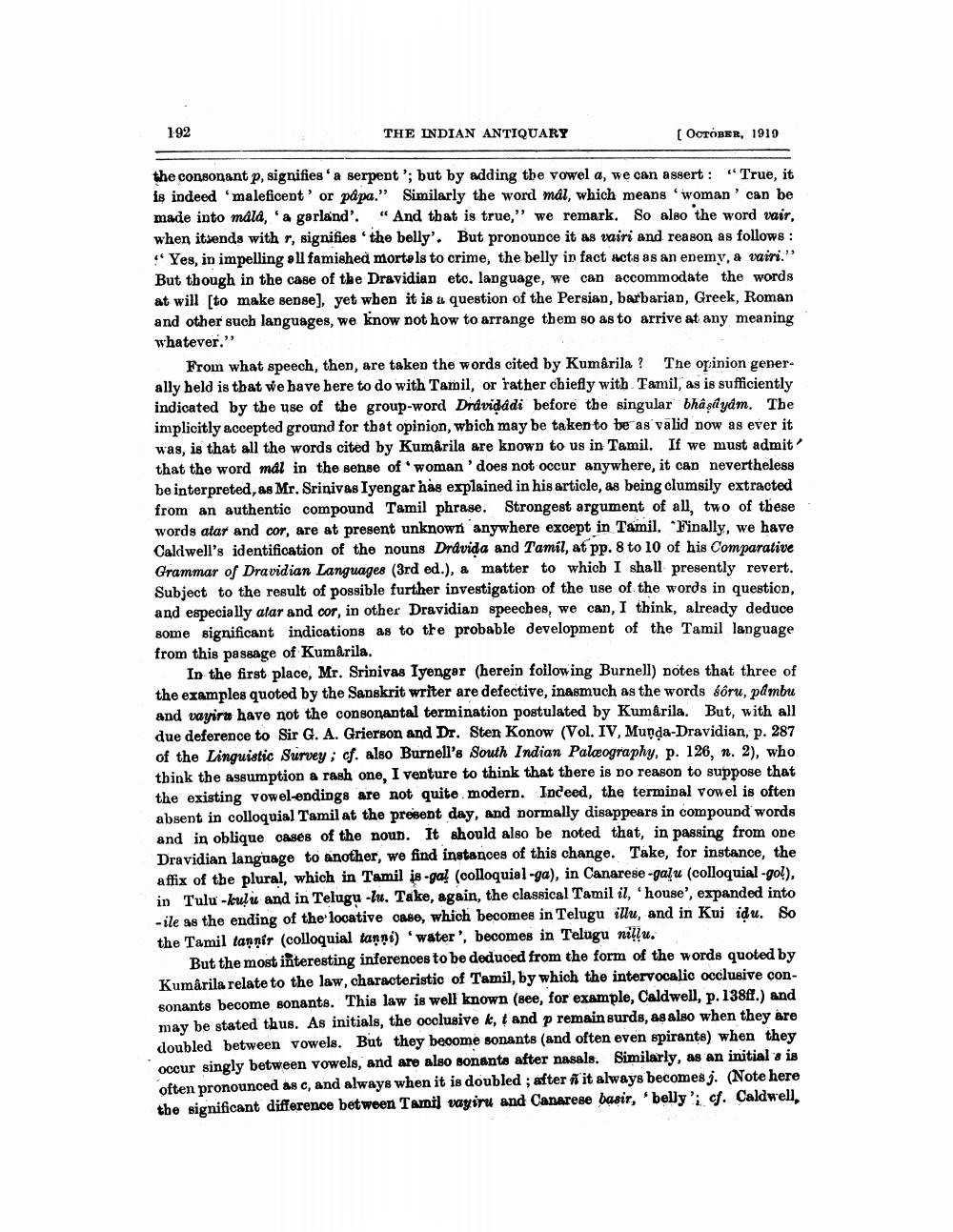________________
192
THE INDIAN ANTIQUARY
(OCTOBER, 1919
the consonant p, signifies a serpent'; but by adding the vowel a, we can assert: " True, it is indeed maleficent' or påpa." Similarly the word mal, which means 'woman' can be made into mala, 'a garland'. "And that is true," we remark. So also the word vair, when itsends with r, signifies the belly'. But pronounce it as vairi and reason as follows :
Yes, in impelling all famished mortels to crime, the belly in fact acts as an enemy, a vairi." But though in the case of the Dravidian etc. language, we can accommodate the words at will [to make sense), yet when it is a question of the Persian, barbarian, Greek, Roman and other such languages, we know not how to arrange them so as to arrive at any meaning whatever."
From what speech, then, are taken the words cited by Kumarila ? The opinion generally held is that we have here to do with Tamil, or rather chiefly with Tamil, as is sufficiently indicated by the use of the group-word Drávidadi before the singular bhâsiydm. The implicitly accepted ground for that opinion, which may be taken to be as valid now as ever it was, is that all the words cited by Kumârila are known to us in Tamil. If we must admit' that the word mal in the sense of woman' does not occur anywhere, it can nevertheless be interpreted, as Mr. Srinivas Iyengar has explained in his article, as being clumsily extracted from an authentic compound Tamil phrase. Strongest argument of all, two of these words atar and cor, are at present unknown anywhere except in Tamil. Finally, we have Caldwell's identification of the nouns Dravida and Tamil, at pp. 8 to 10 of his Comparative Grammar of Dravidian Languages (3rd ed.), a matter to which I shall presently revert. Subject to the result of possible further investigation of the use of the words in question, and especially atar and cor, in other Dravidian speeches, we can, I think, already deduce some significant indications as to the probable development of the Tamil language from this passage of Kumârila.
In the first place, Mr. Srinivas Iyenger (herein following Burnell) potes that three of the examples quoted by the Sanskrit writer are defective, inasmuch as the words sõru, pambu and variru have not the consonantal termination postulated by Kumarila. But, with all due deference to Sir G. A. Grierson and Dr. Sten Konow (Vol. IV, Mupda-Dravidian, p. 287 of the Linguistic Survey; cf. also Burnell's South Indian Palæography, p. 126, n. 2), who think the assumption a rash one, I venture to think that there is no reason to suppose that the existing vowel-endings are not quite modern. Indeed, the terminal vowel is often absent in colloquial Tamil at the present day, and normally disappears in compound words and in oblique cases of the noun. It should also be noted that, in passing from one Dravidian language to another, we find instances of this change. Take, for instance, the affix of the plural, which in Tamil is-ga! (colloquial-ga), in Canarese-gaļu (colloquial-gol), in Tulu -kulu and in Telugu -Iu. Take, again, the classical Tamil il, 'house', expanded into -ile as the ending of the locative case, which becomes in Telugu illu, and in Kuj idu. So the Tamil tannir (colloquial tanni) 'water', becomes in Telugu nil?u.
But the most interesting inferences to be deduced from the form of the words quoted by Kumârila relate to the law, characteristic of Tamil, by which the intervocalic occlusive consonants become sonants. This law is well known (see, for example, Caldwell, p. 138ff.) and may be stated thus. As initials, the occlusive k, t and p remain surds, as also when they are doubled between vowels. But they become sonants (and often even spirants) when they occur singly between vowels, and are also sonants after nasals. Similarly, as an initial is often pronounced as c, and always when it is doubled ; after ñ it always becomes j. (Note here the significant difference between Tamil vayin and Canarese basir, 'belly'; cf. Caldwell,




